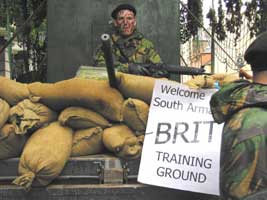7 October 2004 Edition
End the military occupation of South Armagh

Last week, members of the British Army, in full camouflage gear, brought their armoured vehicle to the gates of Leinster House.
This was no decisive twist in the Peace Process, however, but a protest stunt organised by the South Armagh Demilitarisation Committee to show TDs returning from their long summer break what it is like to live under constant military occupation and surveillance.
South Armagh is one of the most beautiful places in Ireland. Towering mountains, rolling fields, rivers, loughs and picturesque villages, together with ancient monuments combine to produce an area of outstanding natural beauty, which should be a magnet for tourists and a joy to its inhabitants.
It was all of these things until the British Government decided to impose a military occupation on a scale unheard of in this country since the 1920s. The British Army began fortifying hilltops and villages in the 1980s. The busiest helicopter base in Western Europe was established in Bessbrook, effectively cutting the village in half. Huge installations were built beside schools and churches, forcing the closure of one large primary school at Clough and prompting teachers across the county to publicly express their concerns for the welfare of their pupils — most notably in Forkhill where the installation's helicopter landing area is just yards from the school building.
Information began to leak out about sinister surveillance activities in the area. Large communication masts were erected at every major and minor British Army installation in South Armagh amid growing fears for the health of people living near these bases.
The 1990s brought hope to the people of South Armagh, who felt the ceasefires and the signing of the Good Friday Agreement would bring an end to the military occupation of the area. The British Government undertook to demilitarise the North.
The reality, however, is very different.
South Armagh has experienced an increase in helicopter overflights, British Army patrols and nuisance roadblocks.
Installations have been refortified and new, larger, communication masts have been erected. After the token removal of a small number of installations, the British Army and PSNI expanded their activities on the ground and in the air to unprecedented levels.
The effect on the health of the local population, created by the large number of powerful surveillance and communication masts, has been a cause of great concern within South Armagh. The British Government has ignored this threat in the same way they have ignored their obligations under the Good Friday Agreement.
A number of studies have been carried out into the cancer inducing properties of the surveillance equipment used by the British Army and PSNI in South Armagh and other areas of the North.
Over the past number of years, the South Armagh Demilitarisation Committee has campaigned on the issue of the continued occupation of this part of Ireland.
Along with other groups, it is dedicated to ending this intolerable situation and has organised protests, rallies, conferences and produced documented evidence of the British Government's failure to implement the Good Friday Agreement in relation to demilitarisation.
The campaign has vowed to continue to campaign for an end to the occupation of South Armagh as a matter of right rather than an item on a political negotiating table.



